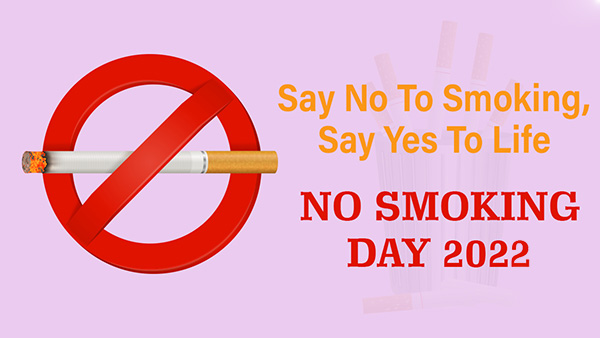No Smoking Day is observed every year on the second Wednesday of March to let them know about the massive side effects of smoking and encourage them to quit it.
This year, No Smoking Day is being observed on March 9. It is mainly celebrated in the United Kingdom inspired by No Tobacco Day.
According to the Global Youth Tobacco Survey (GYTS) conducted by the International Institute of population sciences (IIPS), 8.5%of students — 9.6% of boys and 7.4% of girls — currently used any tobacco products.

No Smoking day 2022
History of No Smoking Day
The United Kingdom witnessed that the people in the country are getting addicted to smoking. In 1984, No Smoking Day was observed for the first time. Earlier, it was celebrated on the first Wednesday of March as it began on Ash Wednesday. However, with time, it shifted to the second Wednesday. Now, it is celebrated as an annual event all over the United Kingdom and in other countries too.
Theme of No Smoking Day 2022
In March 2022, the theme of No Smoking Day is said to be ‘quitting smoking doesn’t have to be stressful.’ The focus of this year will be on calming down people who want to quit smoking and letting them know that the process of giving up on smoking need not be stressful.
Significance of No Smoking Day
This day is celebrated to make people aware of the ill effects of smoking so that they can make up their mind to quit. Various campaigns are organised to provide free resources to people who want to start their journey of giving up on smoking. On this day, people also help their loved ones by extending their hands of support in quitting the life-threatening habit.
Highlights of GYTS Survey 2019
*8.5% of students — 9.6% of boys and 7.4% of girls — currently used any tobacco products.
*Highest current use of any tobacco was in Arunachal Pradesh & Mizoram (58% each) and lowest in Himachal Pradesh (1.1%).
*7.3% of students — 8.3% of boys and 6.2% of girls — currently smoked tobacco.
*4.1% of students—s 4.6% of boys and 3.4% of girls—s currently used smokeless tobacco.
*2 in 10 current smokers — 25% of boys and 13% of girls — tried to quit smoking in the past 12 months.
*21% of current smokers wanted to quit smoking now.
*27% of current users of smokeless tobacco — 28% of boys and 25% of girls — tried to quit using in past 12 months.
*1 in 4 current users of smokeless tobacco wanted to quit now.
So far, four rounds of GYTS have been conducted in 2003,2006, 2009, 2019.
What will happen if you quit tobacco?
In 8 hours: Oxygen levels return to normal.
In 24 hours: The risk of heart attack begins to decrease.
In 72 hours: Lung function improves.
In 1-9 months: Coughing and shortness of breath decreases.
In 12 months: The risk of heart disease is half as compared to tobacco users.
In 5 years: Stroke risk is reduced.
In 10 years: The risk of lung cancer is less than half as compared to tobacco users.
In 15 years: The risk of heart disease is similar to a person who never smoked. Reduced risk of diseases attributable to tobacco use
How dangerous is tobacco for you?
Smoking is the major risk factors for Cancer, Cardiovascular Diseases (CVD), Diabetes, Chronic Lung Disease, stroke, infertility, blindness, Tuberculosis (TB), Oral Cavity etc.
50% of cancers in males and 20% cancers in females
40% of TB and other related diseases
Effects of smoking:
Cough and throat irritation
Bad breath and bad-smelling clothes
Patchy skin and discolouration of teeth
Serious fetal conditions
Heart diseases and Lung cancer
Over time, more serious conditions may develop, including health problems like heart disease, bronchitis, pneumonia, stroke, and many types of cancer, out of which, oral cancer is quite common.
Economic cost of tobacco use
Economic costs attributable to tobacco use in 2011 for persons aged 35-69 is Rs 1,04,500 crores.

